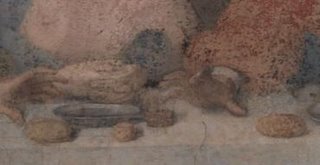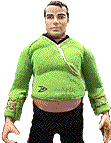Monday, July 31, 2006
What makes it great? (part 3)
Even though I could probably blog for a month about the greatness of Leonoardo's The Last Supper, I think I'm going to restrain myself and wrap it up today. Late last week I asked you to do some homework on chiaroscuro and sfumato. Although experts mostly agree that he perfected these techniques during the Mona Lisa years, it is my belief that he incorporated them into his towering masterpiece in the Dominican dining room to provide artistic excellence to what one writer has called "the most thought–out picture in Western art".
One of the aspects of the genius that can be seen in The Last Supper is the dramatic play of light and shadow. As you view the image, is it obvious where the light source is? Although the event was described as taking place in the evening (Matthew 26:20; Mark 14:17), the artist paints the landscape and blue sky outside the window in broad daylight. One could therefore expect for the faces of Jesus and His disciples to be in the shadows, but instead they seem to be illuminated from another source. As you look at the other faces, it becomes clear that that Jesus himself is that radiant source. Careful observation will demonstrate a third light source, one that takes its cue from the painting's setting and the direction of the natural light in the refectory. What makes this effect even more striking is how Judas becomes cast in shadow as a result, having been thrust forward from the interaction between Peter and John.
 The final note I'd like to make about what makes Leonardo's The Last Supper such a great work of art is the details he uses to tell the dramatic story. Do you see the foreshadowing in the blade being wielded by Peter?
The final note I'd like to make about what makes Leonardo's The Last Supper such a great work of art is the details he uses to tell the dramatic story. Do you see the foreshadowing in the blade being wielded by Peter?
 Some contend that the hand sticking out thrusting a knife is something of a phantom, seeming not to belong to any of the disciples. However, the sketch points out that Leonardo had studied this and was purposeful about the positioning.
Some contend that the hand sticking out thrusting a knife is something of a phantom, seeming not to belong to any of the disciples. However, the sketch points out that Leonardo had studied this and was purposeful about the positioning.
Note also the detail of both Judas and Jesus reaching for bread at the same moment.
 These are just a few of the little details that the artist included to capture that moment, a mere glimpse at what makes this work of art so great. In it we see not only the deft touch of the master's hand, but also the unfolding of the drama that took place in that upper room the night before the Master was crucified.
These are just a few of the little details that the artist included to capture that moment, a mere glimpse at what makes this work of art so great. In it we see not only the deft touch of the master's hand, but also the unfolding of the drama that took place in that upper room the night before the Master was crucified.
Links to this post
- chiaroscuro
- (kee-ahr-uh-skew-roh): A technique of painting in which the figures portrayed have no clear outlines. Instead they are shown emerging into the light from shadows. In Italian the word means "light-dark."
- sfumato
- (sfoo-mah-toe): Italian for "smoky." An oil painting technique in which the artist coats the objects in a picture with layers of very thin paint to soften edges and blur shadows. This creates a dreamlike effect of atmospheric mist or haze.
One of the aspects of the genius that can be seen in The Last Supper is the dramatic play of light and shadow. As you view the image, is it obvious where the light source is? Although the event was described as taking place in the evening (Matthew 26:20; Mark 14:17), the artist paints the landscape and blue sky outside the window in broad daylight. One could therefore expect for the faces of Jesus and His disciples to be in the shadows, but instead they seem to be illuminated from another source. As you look at the other faces, it becomes clear that that Jesus himself is that radiant source. Careful observation will demonstrate a third light source, one that takes its cue from the painting's setting and the direction of the natural light in the refectory. What makes this effect even more striking is how Judas becomes cast in shadow as a result, having been thrust forward from the interaction between Peter and John.
 The final note I'd like to make about what makes Leonardo's The Last Supper such a great work of art is the details he uses to tell the dramatic story. Do you see the foreshadowing in the blade being wielded by Peter?
The final note I'd like to make about what makes Leonardo's The Last Supper such a great work of art is the details he uses to tell the dramatic story. Do you see the foreshadowing in the blade being wielded by Peter? Some contend that the hand sticking out thrusting a knife is something of a phantom, seeming not to belong to any of the disciples. However, the sketch points out that Leonardo had studied this and was purposeful about the positioning.
Some contend that the hand sticking out thrusting a knife is something of a phantom, seeming not to belong to any of the disciples. However, the sketch points out that Leonardo had studied this and was purposeful about the positioning.Note also the detail of both Judas and Jesus reaching for bread at the same moment.
 These are just a few of the little details that the artist included to capture that moment, a mere glimpse at what makes this work of art so great. In it we see not only the deft touch of the master's hand, but also the unfolding of the drama that took place in that upper room the night before the Master was crucified.
These are just a few of the little details that the artist included to capture that moment, a mere glimpse at what makes this work of art so great. In it we see not only the deft touch of the master's hand, but also the unfolding of the drama that took place in that upper room the night before the Master was crucified.Links to this post
Comments:
Post a Comment
Links to this post:
 |
